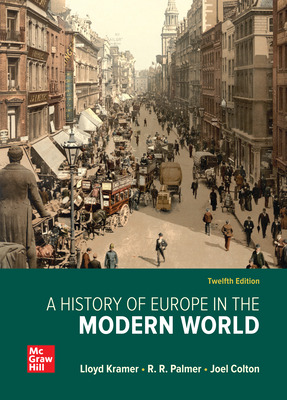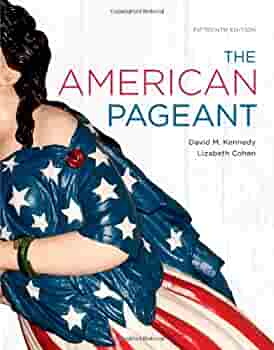Description
Test Bank For A History of Europe in the Modern World 12Th Edition By Lloyd Kramer
The Atlantic World, Commerce, and Wars of Religion, 1560-1648
Multiple Choice Questions
1. (p. 103) The period of religious wars, from 1560 to 1648, _____.
A. profited Spain
B. increased the strength of Germany
C. positioned the English, Dutch, and French to profit from global economic changes
D. inflicted economic disaster upon the Dutch, although they eventually recovered from the damages
Accessibility: Keyboard Navigation
2. (p. 104) After 1492, the Atlantic Ocean became a bridge rather than a barrier for Europeans. As a result, all of the following occurred except:
A. diseases brought from Europe depopulated the Americas.
B. Africa became involved in the transatlantic slave trade.
C. Europeans were able to trade directly with the East for the first time.
D. the Italians expanded their trade networks.
Accessibility: Keyboard Navigation
3. (p. 104) The opening of the Atlantic to transoceanic travel around 1500 was made possible by all of the following except:
A. the Vikings’ voyages to North America.
B. improvements in shipbuilding and sail rigging.
C. the adoption of the mariner’s compass.
D. the Portuguese settlement in the Azores Islands, in the mid-Atlantic.
Accessibility: Keyboard Navigation
4. (p. 105) Which of the following statements is true of the oceanic voyages?
A. Europeans were the first to make long-distance ocean voyages.
B. Columbus was the first European to reach North America.
C. Travelers from Asia had long made voyages to distant places and engaged in trade across the Indian Ocean before Columbus voyaged to the New World.
D. The North Atlantic presented fewer hazards than the Indian or Pacific Oceans.
Accessibility: Keyboard Navigation
5. (p. 106) On his second voyage to the Malabar Coast in 1502, Vasco da Gama:
A. played upon local rivalries and only managed to load his ships with the coveted wares.
B. brought a fighting fleet of no less than 21 vessels, and a war broke out between the Portuguese and Arab merchants.
C. made a deal with the Arab merchants for moving the wares of China and India by caravan over land to the markets of the eastern Mediterranean.
D. helped develop the cities along the Malabar Coast and baptized thousands of souls in India.
Accessibility: Keyboard Navigation
6. (p. 106) When Columbus struck land in 1492 during his first westward voyage to the East, he thought he had found:
A. an outlying part of the Indies.
B. China.
C. Africa.
D. a new continent.
Accessibility: Keyboard Navigation
7. (p. 107-108) By 1575, the Spanish and Portuguese brought more than 120,000 enslaved Africans to their American empires because:
A. they wanted to assimilate their culture with that of the Africans.
B. of the restrictions set by royal authorities on the exploitation of the Indian population.
C. they wanted to replace their native labor, which faced depopulation due to conquest and disease with African slaves.
D. of the threat of revolt from the Indian population.
Accessibility: Keyboard Navigation
8. (p. 108) The first expedition to circumnavigate the globe was:
A. a Spanish expedition led by Christopher Columbus.
B. a Portuguese expedition led by Vasco da Gama.
C. a Spanish expedition led by Ferdinand Magellan.
D. an English expedition led by Sir Francis Drake.
Accessibility: Keyboard Navigation
9. (p. 108) In a treaty of 1494, the monarchs of the _____ peoples asserted that the globe should be divided between them by an imaginary north-and-south line that ran from a point in the middle of the North Atlantic Ocean through the North Pole and across eastern Asia.
A. English and French
B. Spanish and French
C. Spanish and Portuguese
D. Spanish and English
Accessibility: Keyboard Navigation
10. (p. 109) In 1545, with the discovery of the prodigiously rich silver deposits at Potos’ in Peru, _____.
A. Spain’s economy prospered and underwent an early version of the Industrial Revolution
B. the standard of living of the inhabitants of Spanish Peru improved tremendously
C. the European projects of the king of Spain were financed
D. food plants introduced to the Europeans by the Indians became less valuable than silver
Accessibility: Keyboard Navigation
11. (p. 109) All of the following statements are true about Spanish colonization in the Americas except:
A. after the initial ferocity of the conquest, the Spanish crown made efforts to moderate the exploitation of native labor.
B. black African slaves became more important in Spanish America than they were in the French or English colonies.
C. the white population of Spanish America remained relatively small.
D. there was a large class of mestizos, people of mixed white and Indian descent.
Accessibility: Keyboard Navigation
12. (p. 112) Why did the English, Dutch, and French fail to begin colonization of the Americas until more than a hundred years after the Spanish and Portuguese?
A. Their geographical position put them at a disadvantage for transatlantic shipping.
B. Domestic troubles and religious controversies delayed organized government action.
C. The northerners were slow to abandon their traditional trade routes through the Mediterranean.
D. A 1494 treaty ceded the Americas and a monopoly of the trade with the Far East to Portugal and Spain.
Accessibility: Keyboard Navigation
13. (p. 112) Europe’s great economic readjustment after 1500 included:
A. rapid population growth and a gradual rise in prices.
B. rapid population growth and economic stagnation.
C. slow population growth and a steady rise in prices.
D. slow population growth and economic stagnation.
Accessibility: Keyboard Navigation
14. (p. 113) The price revolution of the sixteenth century was due to all of the following except:
A. the flow of gold and silver from the Americas to Europe.
B. the rapid rise in population.
C. the debasement of European currencies by several monarchs.
D. a decline in the amount of land under cultivation, which caused food prices to rise.
Accessibility: Keyboard Navigation
15. (p. 113-114) The “Commercial Revolution” of the early modern period:
A. was actually slow and protracted.
B. signified the rise of a capitalistic economy.
C. signified the transition from a town-centered system to a national economic system.
D. All of these are correct.
Accessibility: Keyboard Navigation
16. (p. 114) In the Middle Ages, the term “capital,” as in the capital owned by the master of a workshop, referred to:
A. the master’s money.
B. the master’s house workbench, tools, and materials.
C. the master’s money and his house workbench, tools, and materials.
D. None of these are correct.
Accessibility: Keyboard Navigation
17. (p. 117) The first demands for mass production involved:
A. consumer goods.
B. military goods.
C. luxury goods.
D. capital equipment.
Accessibility: Keyboard Navigation
18. (p. 116) The domestic system employed in the early modern European economy was a:
A. system of rural household industry.
B. system involving the widespread use of rural people as servants in urban homes.
C. system of high tariffs to guard domestic goods against foreign competition.
D. system where only women were involved.
Accessibility: Keyboard Navigation
19. (p. 117-118) All of the following statements are true about the practice of charging interest on loans except that:
A. it was forbidden by the church or in the canon law during the Middle Ages.
B. it was frowned upon in the sixteenth century by most sectors of society.
C. it was denounced by Martin Luther.
D. it was rarely practiced in the fifteenth and sixteenth centuries.
Accessibility: Keyboard Navigation
20. (p. 118) In the sixteenth century, in the era of commercial capitalism, the key figure in business was the:
A. industrialist.
B. producer of manufactured goods.
C. investment banker.
D. merchant.
Accessibility: Keyboard Navigation





Be the first to review “Test Bank For A History of Europe in the Modern World 12Th Edition By Lloyd Kramer”